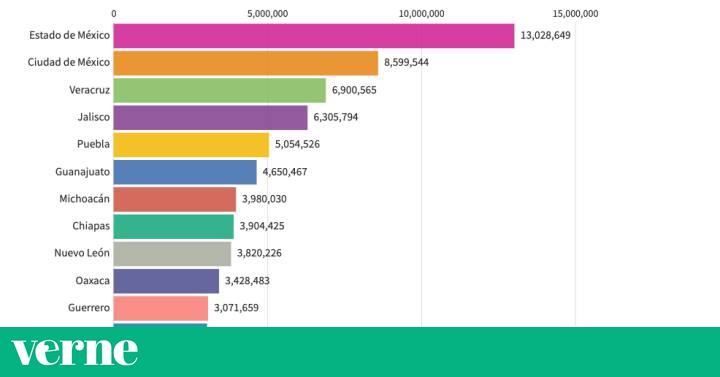The results of the Population and Housing Census released by the National Institute of Geography, Statistics and Informatics (INEGI) in recent days show important data on the evolution of the population of Mexico in recent decades.
It is one of the most important statistical exercises to know in depth the structure and characteristics of the population of a country and thus design projects aimed at the well-being of people.
With these figures we have prepared the following moving bar graphs, which show the changes in the Mexican population since 1990 and based on the censuses and inter-censuses prepared by INEGI.
You can play the charts as many times as you like by clicking the play button at the bottom left of each one.
The most populous states
The results of the 2020 Census indicate that the total population in the United Mexican States is 126,014,024 inhabitants.
Although the growth rate has declined steadily since the 1980s, there are entities that grow at a faster rate than others.
The States of the Metropolitan Area of the Valley of Mexico are the ones that grow the most, but the growth of entities such as Veracruz and Oaxaca is also noteworthy.
The least populated states
Unlike European nations, in Mexico, the population has not stopped growing.
States like Colima (the one with the fewest inhabitants in 2020) have grown in population, but have been overtaken by other entities such as Baja California Sur or Quintana Roo, which have had one of the highest growth rates in Mexico.
States with the highest median age
As we have told in
Verne
,
the population of Mexico is aging.
Although it is a country with a mostly young population, in recent decades we can see how the population is getting older, while births have decreased.
In the capital of Mexico, half of the population is 35 years old or younger.
States with the lowest median age
The aging process of the population becomes more evident when the lower median age is seen.
While in 1990 the median age of the youngest states was 19 years, three decades later the youngest is 24 years, as in the case of Chiapas, and it increases to 27 years for Aguascalientes.
States with higher education
The illiteracy rate fell from 9.5% in 2000 to 4.7% in 2020. Conversely, the average level of schooling shows an increasing trend: 7.5 years to 9.7 in 2020. The large cities of Mexico exceed the average schooling per year.
States with less education
The southern and southeastern states of Mexico are below the national average.
Although growth is observed in the years in which it is studied, the rate and amount of growth is lower than in large cities.
Follow Verne México on Facebook, Twitter and Instagram and don't miss your daily ration of internet wonders.





/cloudfront-eu-central-1.images.arcpublishing.com/prisa/EJNVOWXNONDYDIXFYKNSPI2P4Y.jpg)


/cloudfront-eu-central-1.images.arcpublishing.com/prisa/NUZJBZKFJJC3TORYXB6GF6WOEA.jpg)
